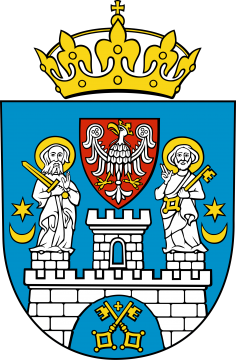
Worth Seeing
Ostrów Tumski
It is definitely worth visiting the Archcathedral Basilica of St. Peter and St. Paul, which holds the remains of Poland’s first rulers. There are relics of the building erected by Duke Mieszko I in the basement. The Archdiocesan Museum is housed in the former Lubrański Academy building. Archeologists can be seen working around the Church of the Blessed Virgin Mary in Summo from spring to autumn.
The Old Town
The renaissance Town Hall, which now houses the Museum of the History of the City of Poznań, is especially noteworthy. Billy goats can be seen butting each other on the Town Hall tower at noon every day. In front of the Town Hall we have the Proserpine fountain, a pillory and merchant’s houses. The Museum of Musical Instruments, one of the largest in the world, is opposite the houses. Tenement number 50 carries a plaque indicating the high watermark during the worst flooding of 1736. The parish church is one of Poland’s most beautiful baroque temples. The Ballet School and Municipal Office both have attractive courtyards. Pl. Kolegiacki has its butting billy goats monument. The Archeological Museum is in the former Górka Palace in ul. Wodna. The renaissance portal is exquisite and the courtyard has the only original Egyptian obelisk in this part of Europe. There is a fragment of the reconstructed medieval city walls in ul. Masztalarska and ul. Wroniecka and a fragment of the walls with two towers between them. The Weapons Museum and the Bamberki Monument where Bamberki (Bambrzy women) gather in folk costume during the first weekend in August, are also in the marketplace. On the other side of the Old Town is the Guardhouse, where the ceremonial changing of the guard of the Poznań Cavalry takes place at noon on Saturdays and Sundays during July and August. Opposite the Guardhouse is Działyński Palace, now the head office of the Polish Academy of Sciences. Ul. Franciszkańska leads to Przemysł Hill. The Museum of Applied Arts can be found in what used to be a wing of the Royal Castle on the summit. The Franciscan church on the other side is also the Sanctuary of the Miraculous Holy Mother - Lady of Poznań. There is a model of Old Poznań with sound and light shows on the history of Poznań from the times of Mieszko to the Second Partition of Poland and the history of 10th-century Ostrów Tumski in the church basement (entrance from ul. Ludgardy). The red cobblestones in the streets of the Old Town mark where the medieval walls and other structures used to be.
Nineteenth Century Poznań
The “Bazar” building is across the street from the National Museum in ul. Paderewskiego. Freedom Sq., where the Wielkopolska Uprising began on 27 December 1918, is further on. The Raczyński Library is in the northern frontage. Founded by Edward Raczyński in 1829, it is the oldest public library in the city. There is a statue of Hygieia bearing the face of the Count’s wife Konstancja in front of the building. The Teatr Polski (Polish Theatre) is in ul. 27 Grudnia. The inscription Naród sobie (the Nation for Itself) commemorates its construction with contributions from the Polish community in 1875. Further along is the Okrąglak (Roundhouse) building, erected as a department store and now an office building. The courtyard of the Poznań Society of Friends of Learning building can be entered from ul. Mielżyńskiego. A copy of the first monument to Adam Mickiewicz on Polish soil can be found there. The original was destroyed by the Germans. The castle precinct is further along ul. Fredry.
Some of the many places worth visiting:
· All Saints Church in Grobla with its Evangelical furnishings
· St. Catherine’s Sisters (now Salesian) Church of Our Lady of Succour to the Faithful with its Gothic “trójdzielne” vault (a rare kind of rib vault unique to Piast Poland) and Gothic peak from ul. Wroniecka
· The Church of St. John of Jerusalem (at the Śródek roundabout) – Poland’s oldest brick temple
· Our Lady of Sorrows Church (ul. Głogowska) with a copy of Michaelangelo’s Pietà
· Poland’s largest Palm House can be found on the grounds of the Poznań International Trade Fair
· The Botanical Gardens in Ogrody
· Poland’s largest zoological gardens on Lake Malta. You can get there by taking the “Maltanka” narrow-gauge rail
· St. Wojciech’s Hill with the Cemetery and Crypt of Distinguished Wielkopolska Residents by St. Wojciech’s church and the Carmelite St. Joseph’s Church
· The Citadel – once the main fort of the 19th-century stronghold, now the site of the city’s biggest park and the main building of the Ordnance Museum
· The Morasko Meteorite Reserve with craters left by a meteor strike about 10,000 years ago – the only reserve of its kind in the world
· Stary Browar – a former brewery converted into a shopping centre and art gallery.
For more information, go to:
www.poznan.pl/en











